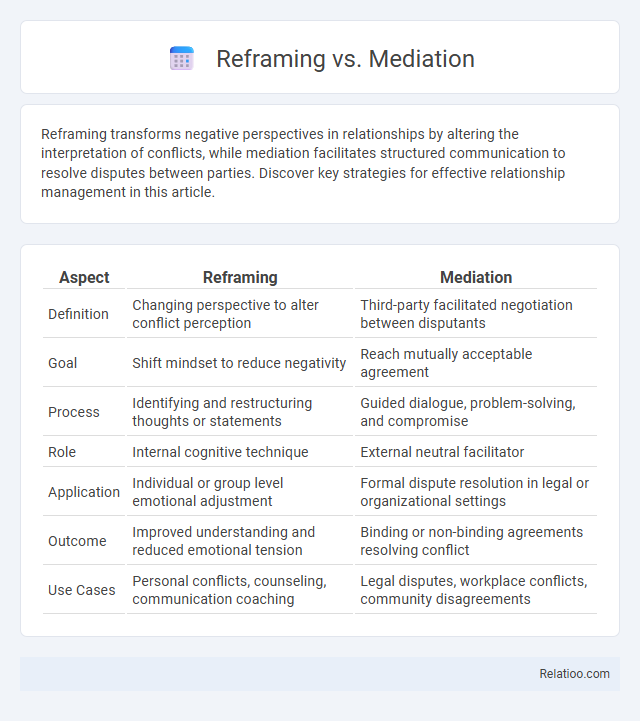Reframing transforms negative perspectives in relationships by altering the interpretation of conflicts, while mediation facilitates structured communication to resolve disputes between parties. Discover key strategies for effective relationship management in this article.
Table of Comparison
| Aspect | Reframing | Mediation |
|---|---|---|
| Definition | Changing perspective to alter conflict perception | Third-party facilitated negotiation between disputants |
| Goal | Shift mindset to reduce negativity | Reach mutually acceptable agreement |
| Process | Identifying and restructuring thoughts or statements | Guided dialogue, problem-solving, and compromise |
| Role | Internal cognitive technique | External neutral facilitator |
| Application | Individual or group level emotional adjustment | Formal dispute resolution in legal or organizational settings |
| Outcome | Improved understanding and reduced emotional tension | Binding or non-binding agreements resolving conflict |
| Use Cases | Personal conflicts, counseling, communication coaching | Legal disputes, workplace conflicts, community disagreements |
Understanding Reframing and Mediation
Reframing involves changing the perspective on a situation to alter its meaning, which can reduce conflict and promote positive thinking. Mediation is a structured process where a neutral third party facilitates communication between disputants to reach a mutual agreement. Understanding these techniques reveals that reframing shifts individual perception internally, while mediation externally navigates negotiation to resolve disputes.
Core Principles of Reframing
Reframing centers on altering the perception of a situation to change its meaning, emphasizing cognitive flexibility and positive interpretation. Unlike mediation, which facilitates negotiation between disputing parties, reframing encourages individuals to shift their perspective internally to resolve conflicts or challenges. Your ability to apply core principles such as context shifting, language adjustment, and viewpoint diversification enhances problem-solving and emotional resilience.
Key Elements of Mediation
Mediation centers on key elements such as neutrality, confidentiality, and voluntary participation, enabling both parties to communicate openly with the help of a trained mediator who facilitates problem-solving without imposing decisions. Reframing, by contrast, involves changing the perspective on a conflict or issue to promote understanding and reduce tension. Your success in resolving disputes largely depends on understanding mediation's structured approach to dialogue and compromise, which distinguishes it from the more cognitive and perspective-based technique of reframing.
Differences Between Reframing and Mediation
Reframing involves altering the perspective on a situation to change its meaning and emotional impact, often used in therapy and conflict resolution to shift negative thoughts into positive or neutral ones. Mediation, on the other hand, is a structured process where a neutral third party facilitates communication and negotiation between disputing parties to help them reach a voluntary agreement. The primary difference lies in reframing being a cognitive technique to modify perceptions, while mediation is a procedural approach aimed at settling disputes through dialogue and compromise.
When to Use Reframing Techniques
Reframing techniques are most effective when you need to shift perspectives and alter your interpretation of challenging situations to uncover new possibilities and solutions. Mediation is better suited for resolving conflicts between parties through facilitated dialogue, while reframing focuses inwardly on changing your own mindset or approach. You should use reframing when you want to overcome cognitive barriers and enhance emotional resilience by seeing a problem or experience in a more constructive light.
When Mediation is Most Effective
Mediation is most effective when parties seek a neutral third party to facilitate communication and resolve conflicts without litigation. Your ability to reach a mutually acceptable agreement often improves through guided negotiation and understanding each other's perspectives. Unlike reframing, which focuses on changing perceptions, mediation actively addresses the underlying issues to promote a collaborative resolution.
Advantages of Reframing in Conflict Resolution
Reframing in conflict resolution shifts the perspective of a dispute, allowing Your focus to move from problems to opportunities for understanding and collaboration. It promotes empathy by helping parties see the issue from different viewpoints, reducing tension and fostering constructive dialogue. Unlike mediation, which often requires a neutral third party, reframing empowers individuals to independently transform conflicts into solutions.
Benefits of Mediation for Dispute Settlement
Mediation offers a confidential and structured environment where You or your organization can resolve disputes amicably, preserving relationships and reducing the costs associated with litigation. Unlike reframing, which shifts perspectives cognitively without necessarily resolving conflict, mediation actively involves a neutral third party who facilitates communication and negotiation to achieve mutually acceptable agreements. This process enhances understanding, fosters collaboration, and provides flexible solutions tailored to the unique needs of all parties involved.
Integrating Reframing with Mediation Processes
Integrating reframing with mediation processes enhances conflict resolution by transforming negative perceptions into constructive dialogue, fostering mutual understanding between parties. Reframing shifts the narrative focus from blame to interests, while mediation provides a structured environment for collaborative problem-solving. This synergy improves communication, reduces emotional tensions, and promotes durable agreements in disputes.
Choosing the Right Approach for Conflict Management
Choosing the right approach for conflict management requires understanding the distinctions between reframing, mediation, and negotiation. Reframing shifts perspectives to reduce emotional tension, mediation involves a neutral third party facilitating dialogue, and negotiation focuses on reaching a mutually beneficial agreement through direct communication. Your effective conflict resolution hinges on selecting the strategy that aligns with the specific dynamics and goals of the dispute.

Infographic: Reframing vs Mediation
 relatioo.com
relatioo.com